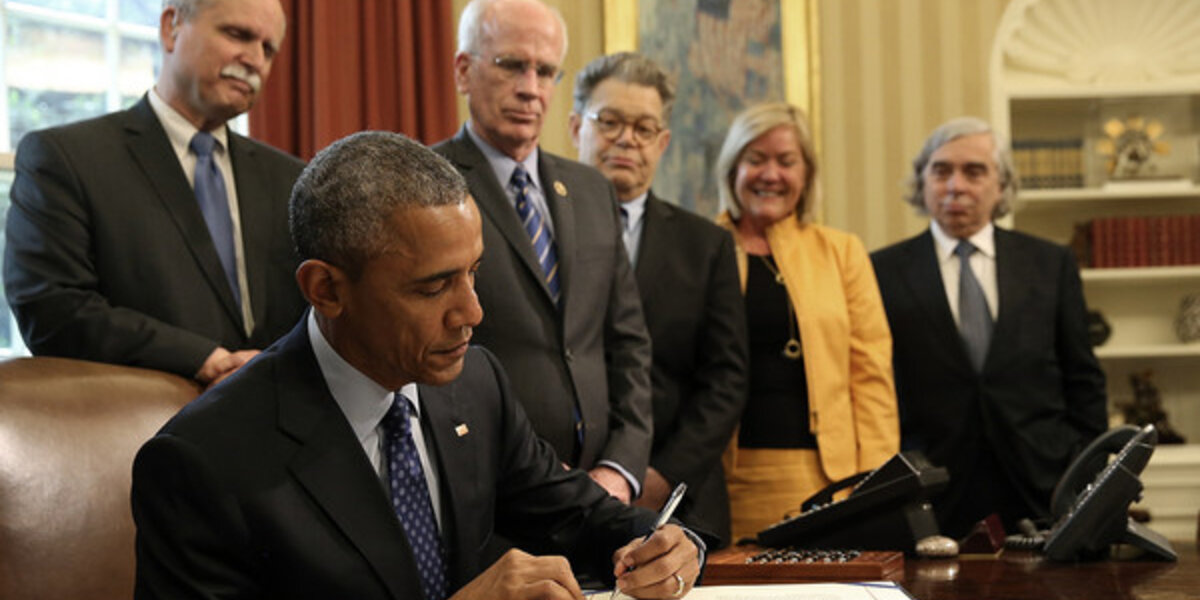Throwback Thursday: What Can We Learn From Past Energy Legislation Success?
Let's Save Energy
Alliance to Save Energy's Blog
Throwback Thursday: What Can We Learn From Past Energy Legislation Success?

Photo: President Barack Obama signing S.535. Left to Right: Alliance Honorary Board Members Rep. David McKinley (R-W. Va.) and Rep. Peter Welch (D-Vt.); Sen. Al Franken (D-Minn.); Alliance to Save Energy President Kateri Callahan. U.S. Secretary of Energy Ernest Moniz.
In the wake of the recent passage of S.2012, Energy Policy Modernization Act of 2016, we want to take this opportunity to “throwback” to another major piece of energy legislation – the passage of S. 535.
One year ago, President Obama made history by signing into law S. 535, the Energy Efficiency Improvement Act – which to this day remains the only energy law enacted during his presidency. In doing so, he showed that energy efficiency is a win, win, win: it can improve our economy, protect our environment and increase our energy security.
The provisions of the package have been projected to save roughly $4.6 billion in annual energy savings by 2030 and produce many other tangible benefits. Furthermore, the enactment of S. 535 last year in April proved that energy efficiency is a bipartisan rallying point. In fact, we point to S. 535 as playing a major role in the strong presence of energy efficiency in the recent passage of S. 2012.
Refresher: What Was in S. 535?
S. 535 included three provisions:
- Better Buildings: In an effort to better align the energy-related interests between commercial building owners and tenants, this provision created a voluntary program, Tenant Star, to promote energy efficiency in separate spaces.
- Water Heater Efficiency Act: Created an exemption for certain grid-enabled electric-resistance water heaters from new efficiency standards. These water heaters are only exempt when used in electric thermal storage or demand response programs.
- Energy Information for Commercial Buildings: Expanded existing law regarding energy use in federal buildings by requiring federally leased buildings to benchmark and disclose their energy usage data as well.
What Contributed to the Success of S. 535?
As the effort to pass energy legislation continues, it is helpful to look back on what elements of S. 535 led to its success:
- Bipartisan support: The bill contained strong energy efficiency provisions. Energy efficiency, which enjoys support from both sides of the aisle, is seen as an effective tool to improve our nation’s economy, energy security and environment.
- Timing: S. 535 began in the Senate. In an effort to successfully pass a budget resolution, the Senate engaged in a “vote-a-rama” that continued into the early morning hours. Once the budget-related amendments were addressed, Alliance Honorary Board Chair Sen. Jeanne Shaheen (D-N.H.) and Vice-Chair Sen. Rob Portman (R-Ohio) took to the floor and urged their colleagues to pass S. 535.
- Time sensitive provision: One of the three provisions, the water heater portion, had a time-sensitive component. A new energy efficiency standard was about to go into effect for certain water heaters, which would have negatively impacted certain communities that rely on them for demand response programs. As the impact was considered widespread, enough momentum was generated to pass this particular provision and protect those communities. Keying in on the motivation created by the water heater provision, legislators were able to combine it with other modest, non-contentious pieces to create an impactful energy efficiency package.
- No price tag: In the current atmosphere of tight budgets and mandatory offsets, another positive aspect to S. 535 stood out – the bill required no federal funding.
Looking Ahead
Energy efficiency is a bipartisan issue that has a strong legacy of bringing legislators together, especially true during the 114th Congress. Beyond the passage of S. 535 last year, we saw energy efficiency featured as a key pillar of S. 2012, which recently passed the Senate on an overwhelmingly supportive 85-12 vote. Furthermore, we observed positive votes on four energy efficiency-related amendments to S. 2012, including the addition of the SAVE Act (66-31 vote) that has long been identified as a priority for the energy efficiency community.
The Alliance to Save Energy and other efficiency advocates now look forward to the next part of the bill process with upcoming conference between the Senate and the House. April proved to be a great month for bipartisanship and energy efficiency, and we hope that the commitment made to energy efficiency thus far will lead to bigger and better things over the remainder of the year.
RECENT BLOG POSTS
STAY EMPOWERED
Help the Alliance advocate for policies to use energy more efficiently – supporting job creation, reduced emissions, and lower costs. Contact your member of Congress.
Energy efficiency is smart, nonpartisan, and practical. So are we. Our strength comes from an unparalleled group of Alliance Associates working collaboratively under the Alliance umbrella to pave the way for energy efficiency gains.
The power of efficiency is in your hands. Supporting the Alliance means supporting a vision for using energy more productively to achieve economic growth, a cleaner environment, and greater energy security, affordability, and reliability.



